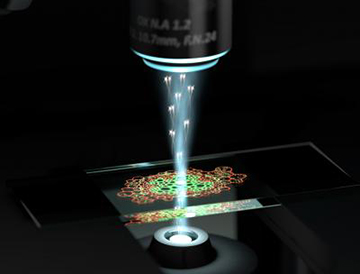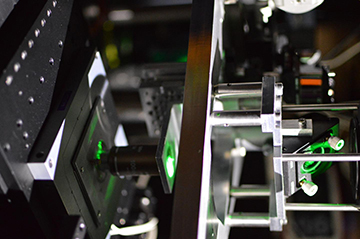
An artist’s rendering of the “quantum microscope“ from scientists in Australia and Germany. The setup reportedly improves stimulated Raman microscopy for biological applications by exploiting correlations between entangled photons. [Image: University of Queensland]
Raising the sensitivity or speed of optical microscopy can be done by boosting the intensity of incoming light. But this approach can only be taken so far when imaging delicate biological tissue.
Researchers in Australia and Germany have now shown how to safely increase performance for nonlinear microscopy, by exploiting the strange properties of entangled photons to overcome otherwise insurmountable shot noise (Nature, doi: 10.1038/s41586-021-03528-w). The team believes that using such quantum correlations could potentially improve microscopes’ performance by an order of magnitude—and in the process enable new insights into processes such as metabolism and antibiotic response.
Weak signal
The work involves a technique called stimulated Raman scattering gain microscopy. Raman scattering is an inelastic process in which a pump photon excites vibrations in a molecule, which then emits a so-called Stokes photon at a lower frequency. The molecule in question is identified by the difference in the two frequencies.
Because this scattering is a very weak effect, a laser at the Stokes frequency is used in addition to one at the Raman frequency. The resulting nonlinear interaction generates a stronger signal, which is further enhanced via constructive interference with the Stokes laser field.
The bigger signal can speed up imaging by as much as a million times compared to linear Raman microscopy. The challenge, however, is to pick out the signal from the far larger background created by the Stokes laser. This becomes a particular problem when the latter fluctuates, as the quantized nature of light imposes a fundamental lower limit on laser noise, known as shot noise.
The signal-to-noise ratio can in principle be raised by increasing the laser intensity to maximize the signal. But there is a limit to the intensity that biological material can withstand before it becomes damaged.
Exploiting squeezed light
In the new research, Catxere Casacio and colleagues at the University of Queensland, Australia, working together with researchers from the University of Rostock, Germany, take the opposite approach: reducing background levels below that of shot noise. They do so by using “squeezed light,” which is made up of entangled photons that are not fully independent of one another and therefore do not fluctuate according to classical statistical distributions.
The potential benefits of such correlated photons for optical measurements have been known about for decades, and other scientists have already shown how they could potentially be used to improve some kinds of microscopy, such as phase-contrast imaging. But because the quantum correlations are very fragile, these demonstrations have been carried out at intensities many orders of magnitude lower than those employed in state-of-the-art microscopes.

Close-up photo of the experimental setup. [Image: University of Queensland]
Casacio and co-workers managed instead to exploit correlated photons at high intensities by using picosecond pulsed sources of squeezed light rather than the continuous-wave sources used previously, as well as by employing very efficient objectives and a low-noise detector. Doing so, their setup was able to outperform conventional microscopy, imaging molecular bonds inside a cell with a 35% better signal-to-noise ratio. As such, it could detect molecules at 14% lower concentrations, while remaining under the threshold for damage.
Removing a “fundamental barrier”
“Our microscope operates safely beyond this limit, showing that quantum correlations can evade light-induced damage,” the research team writes. “This removes a fundamental barrier to advances in coherent Raman microscopy and high-performance microscopy more broadly.”
The researchers acknowledge that the numerical gains they have made are fairly modest. They point out that the technology for generating and detecting picosecond squeezed light at high intensities is at an early stage and that they were unable to achieve high optical efficiencies in their experiment. But they reckon there is plenty of room for improvement, noting that squeezed-light technology has allowed scientists to increase the signal-to-noise ratio of gravitational-wave detectors by up to 30 times.
Taking into account optical losses from their objectives, the team maintains that it could ultimately improve either the signal-to-noise ratio or the speed of Raman microscopy by about a factor of ten. This, the researchers say, will allow biologists to better observe a range of phenomena without having to use fluorescent labels, which have a poorer spectral resolution and can interfere with a system’s dynamics. Such phenomena include metabolic processes, nerve degeneration, neuron membrane potentials and antibiotic response.
